Coolers and Freezers
How Did the City of Fresno Go Tiny House

How did Fresno become a hub for tiny houses?
Join me as we delve into the fascinating journey of this city embracing the tiny house movement. We’ll explore the challenges Fresno faced, the regulatory changes that paved the way, and their innovative approach to building a thriving tiny house community.
Through their experiences, we’ll discover valuable lessons learned and gain insight into how Fresno successfully transitioned to a more sustainable and affordable way of living.
Key Takeaways
- Fresno’s success in the tiny house movement has demonstrated that affordable and sustainable housing can be achieved.
- The city of Fresno overcame challenges by revising zoning regulations and providing resources and education to residents.
- Fresno’s approach to building a tiny house community involved flexible regulations, public-private partnerships, and community engagement.
- Community engagement and collaboration were crucial factors in Fresno’s success, creating a strong and supportive network among residents.
The Shift Towards Tiny Living in Fresno
I personally believe that the shift towards tiny living in Fresno has been a positive and exciting development. The tiny house movement has gained momentum in recent years, offering affordable housing options for those looking to downsize or reduce their environmental footprint.
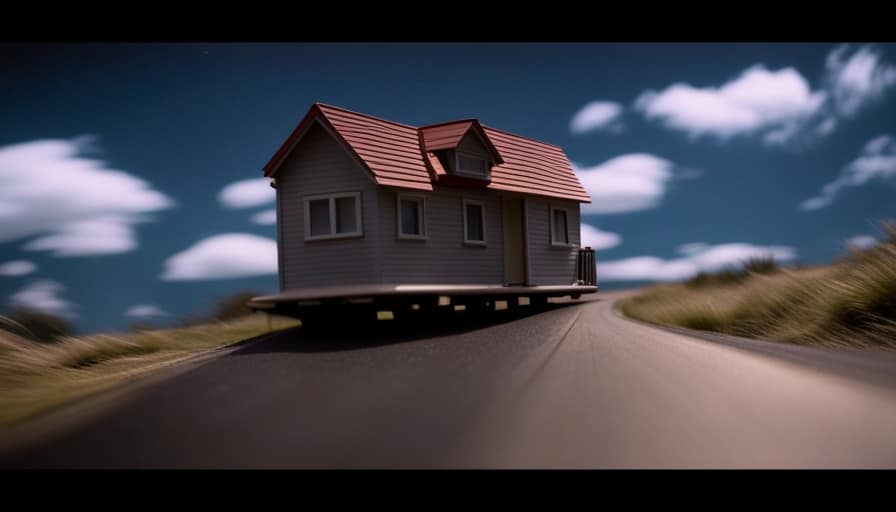
Fresno, like many other cities, has recognized the benefits of embracing this trend. By promoting the construction and integration of tiny homes into the community, Fresno has created new opportunities for individuals and families who may have previously struggled to find affordable housing. These tiny homes not only provide a more cost-effective alternative to traditional housing, but they also promote a simpler and more sustainable lifestyle.
The city’s commitment to supporting the tiny house movement has helped address the housing needs of its residents while also fostering a stronger sense of community and environmental stewardship.
Overcoming Challenges: Fresno’s Journey to Embrace Tiny Houses
Despite the obstacles faced, Fresno has successfully navigated its journey to embrace tiny houses. Here are four key factors that contributed to the city’s success:
-
Revising Zoning Regulations: Fresno recognized the need to update its zoning codes to accommodate tiny houses. By allowing for smaller minimum square footage requirements and permitting tiny houses on wheels as accessory dwelling units, the city created more opportunities for tiny house living.
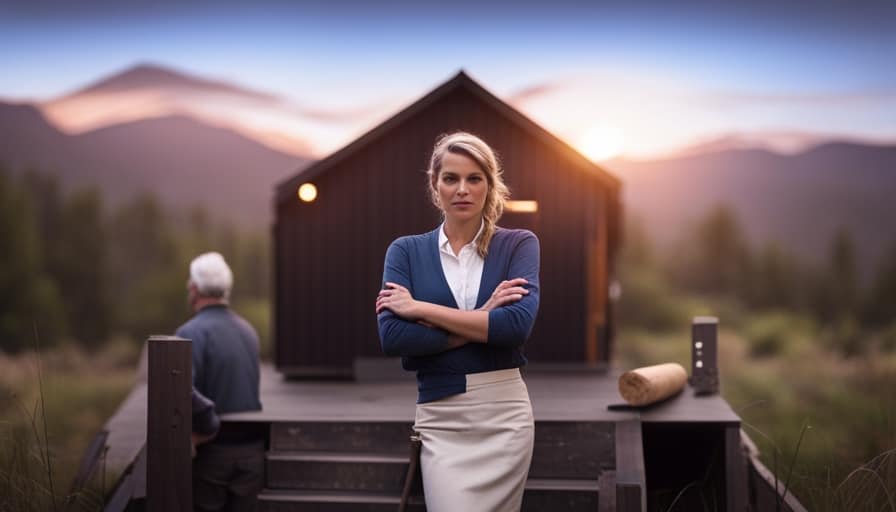
-
Engaging the Community: Fresno actively sought input from residents, builders, and advocates to understand their needs and concerns. By fostering open dialogue and involving the community in the decision-making process, the city gained valuable support and built a sense of ownership among its residents.
-
Providing Resources and Education: Fresno developed resources and educational programs to help residents navigate the process of building and living in tiny houses. This included workshops, online guides, and partnerships with local organizations to provide financial assistance and support.
-
Promoting Sustainable and Affordable Housing: Fresno recognized the potential of tiny houses to address its housing challenges. By highlighting the environmental and financial benefits of tiny living, the city gained broader support for its efforts and positioned tiny houses as a viable solution for affordable and sustainable housing.
Through careful consideration of zoning regulations, strong community engagement, resource provision, and a focus on sustainability and affordability, Fresno successfully overcame challenges to embrace tiny houses and create a more inclusive and diverse housing landscape for its residents.

Regulatory Changes: Paving the Way for Tiny House Living in Fresno
One of the key regulatory changes that paved the way for tiny house living in Fresno was the revision of zoning codes. The city recognized the need to adapt to the growing trend of tiny houses and made significant regulatory updates to accommodate this form of housing.
Zoning adjustments were made to allow tiny houses on individual lots, as well as in designated tiny house communities. These changes provided clarity and guidelines for developers and homeowners interested in building or living in tiny houses.
Building a Tiny House Community: Fresno’s Innovative Approach
The city of Fresno took a unique approach to building a tiny house community, focusing on building regulations and community support. Here are four key aspects of Fresno’s innovative approach:
-
Flexible regulations: Fresno revised its building codes to accommodate tiny houses, allowing for smaller minimum square footage requirements and more flexible zoning regulations.
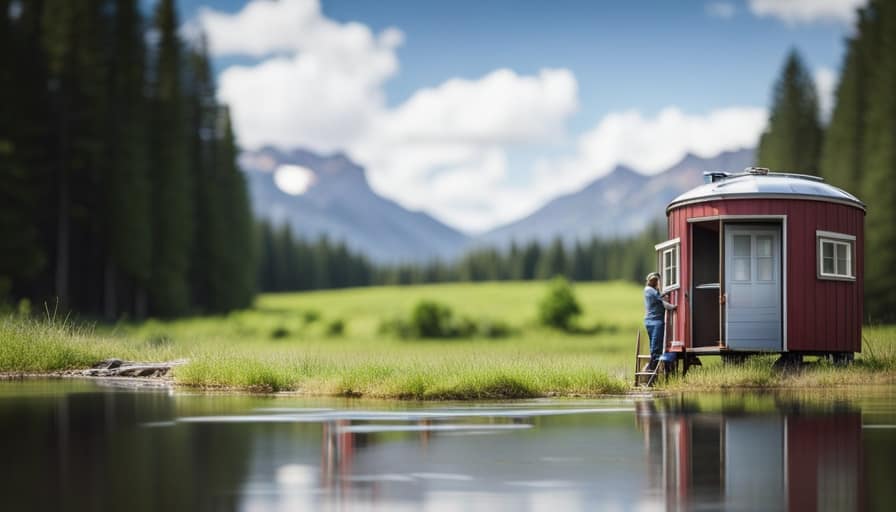
-
Public-private partnerships: Fresno collaborated with non-profit organizations and private developers to create affordable housing options within the tiny house community, leveraging community support and resources.
-
Community engagement: Fresno actively sought input from residents and stakeholders through public meetings and forums, ensuring that the tiny house community meets the needs and preferences of the local community.
-
Supportive services: Fresno incorporated on-site support services, such as counseling, job training, and healthcare facilities, to provide residents with the necessary resources for a successful transition to tiny house living.
Lessons Learned: Fresno’s Success Story in the Tiny House Movement
I have learned valuable lessons from Fresno’s success story in the tiny house movement, including the importance of community collaboration and innovative housing solutions.
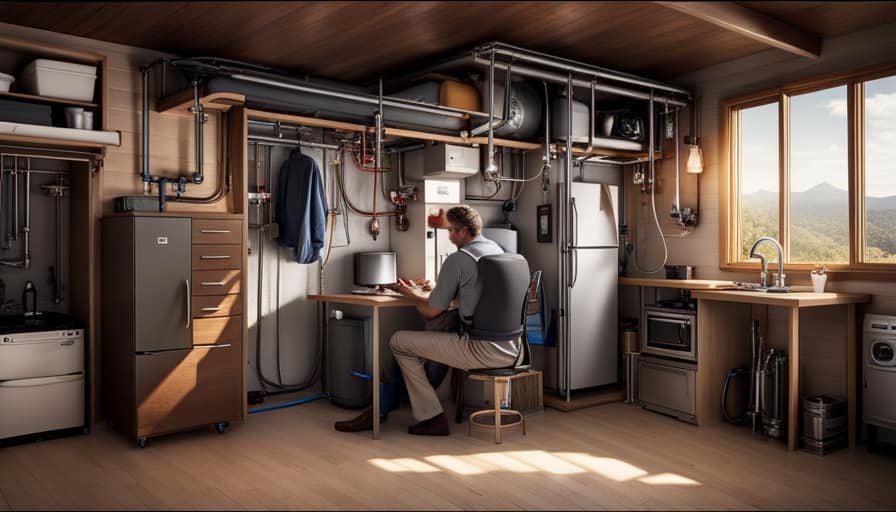
Fresno’s impact in the tiny house movement has been significant, proving that with the right approach, affordable and sustainable housing can be achieved.
One key lesson learned is the power of community engagement. Fresno actively involved its residents in the decision-making process, seeking their input and feedback. This not only created a sense of ownership and pride among community members but also ensured that the tiny house community met their needs and preferences.
Another lesson learned is the importance of innovative housing solutions. Fresno embraced the concept of tiny houses as a viable alternative to traditional housing, offering a solution to the affordable housing crisis. By thinking outside the box and implementing innovative solutions, Fresno has become a model for other cities to follow in the tiny house movement.
Frequently Asked Questions
What Is the Average Cost of a Tiny House in Fresno?
The average cost of a tiny house in Fresno is around $50,000. There are various financing options available, such as loans and grants, to help make owning a tiny house more affordable.

Are There Any Restrictions on the Size or Design of Tiny Houses in Fresno?
There are regulations and zoning requirements for tiny houses in Fresno. The city has specific size and design restrictions in place to ensure compliance with safety and building codes.
How Can I Find Land or a Community to Park My Tiny House in Fresno?
To find land or a community to park my tiny house in Fresno, I would start by researching tiny house communities in the area. It’s important to also consider zoning regulations to ensure compliance and a smooth transition into the community.
Are There Any Financial Assistance Programs Available for Building or Purchasing a Tiny House in Fresno?
There are financial assistance programs available for building or purchasing a tiny house in Fresno. Funding options include loans, grants, and tax incentives. These programs aim to make tiny house living more accessible and affordable for residents.
What Resources or Organizations Are Available in Fresno to Help With the Construction and Maintenance of Tiny Houses?
Tiny house construction assistance can be found through organizations like Fresno Housing Authority and Habitat for Humanity. Maintenance support is available through local handyman services and community workshops.

Conclusion
In conclusion, the city of Fresno has successfully embraced the tiny house movement by overcoming challenges, implementing regulatory changes, and building an innovative tiny house community.
Their journey serves as a valuable lesson in adapting to changing housing needs and finding creative solutions.
As the saying goes, ‘Good things come in small packages,’ and Fresno’s success story in going tiny house is a testament to the power of thinking outside the box and embracing new possibilities for sustainable living.
I’m Theodore, and I love tiny houses. In fact, I’m the author of Tiny House 43, a book about tiny houses that are also tree houses. I think they’re magical places where imaginations can run wild and adventures are just waiting to happen.
While tree houses are often associated with childhood, they can be the perfect adult retreat. They offer a cozy space to relax and unwind, surrounded by nature. And since they’re typically built on stilts or raised platforms, they offer stunning views that traditional homes simply can’t match.
If you’re looking for a unique and romantic getaway, a tree house tiny house might just be the perfect option.
Coolers and Freezers
How Do I Hang Laundry in a Tiny House
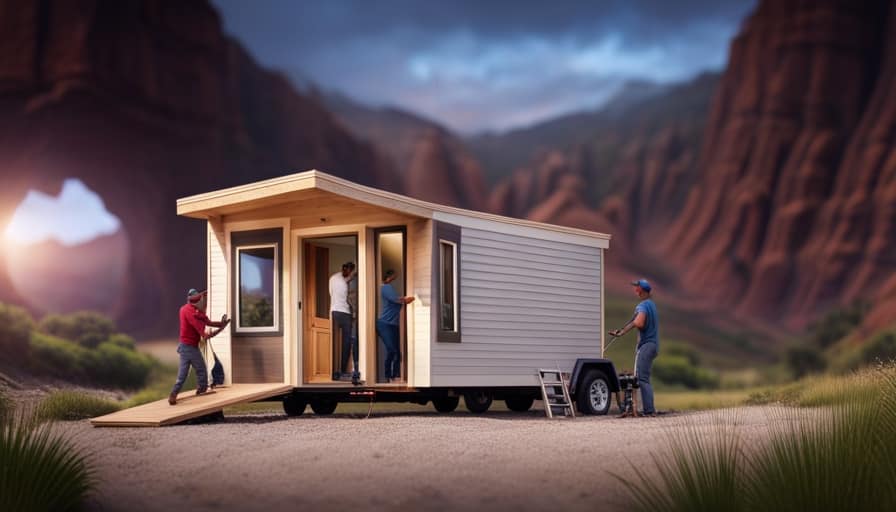
I have always been a fan of the concept of residing in a small house, however, one obstacle I encountered was figuring out a way to hang my clothes. Due to the lack of space, I had to think outside the box.
That’s when I discovered the power of utilizing vertical space and thinking outside the clothesline. In this article, I’ll share practical tips and space-saving hacks for maximizing your wall space, finding creative drying solutions, and organizing your laundry essentials in a compact space.
Get ready to transform your tiny house laundry routine!
Key Takeaways
- Utilize vertical space by installing hooks, wall-mounted drying racks, and compact laundry racks to maximize wall space in a tiny house.
- Get creative with drying solutions by using drying racks, hooks, and retractable clotheslines to make the most of limited space.
- Implement space-saving laundry hacks such as using folding techniques like the KonMari method and investing in collapsible or foldable storage containers.
- Optimize storage with smart solutions like compact laundry baskets, hidden storage options like built-in cabinets or shelves, and wall-mounted drying racks.
Utilizing Vertical Space: Maximizing Your Wall Space for Hanging Laundry
I can maximize my wall space by installing a few hooks for hanging laundry in my tiny house. However, if I want to take it a step further and really make the most of my limited space, I should consider investing in compact laundry racks or wall-mounted drying racks.

These innovative solutions allow me to hang multiple items at once without taking up valuable floor space. Compact laundry racks are designed to be collapsible, making them easy to store when not in use. On the other hand, wall-mounted drying racks can be mounted on the wall, providing a permanent and space-saving solution.
Creative Drying Solutions: Thinking Outside the Clothesline
To maximize drying space in my tiny house, I can explore alternative options such as using drying racks, hanging laundry from hooks, or utilizing retractable clotheslines. These indoor drying options are great alternatives to traditional clotheslines, especially when space is limited. By thinking outside the clothesline, I can find innovative folding techniques that will help me maximize drying space in a small area.
Here is a table showcasing some creative drying solutions:
| Option | Description | Benefits |
|---|---|---|
| Drying Racks | These racks can be folded and stored when not in use. They provide ample space for hanging clothes. | Maximizes drying space, easy to store |
| Hanging Laundry from Hooks | Installing hooks on walls or ceilings allows for vertical drying space. | Saves floor space, utilizes vertical space |
| Retractable Clotheslines | These can be mounted indoors and extended when needed. They can be easily folded back when not in use. | Provides flexibility, doesn’t take up permanent space |
Space-Saving Laundry Hacks: Making the Most of Your Tiny House
Maximize your laundry space in a tiny house with these space-saving laundry hacks.

When it comes to folding techniques, it’s important to maximize storage for folded laundry in a small space. Consider using techniques like the KonMari method, where you fold clothes into small, compact rectangles that can be easily stacked or stored in drawers. Another option is to invest in collapsible or foldable storage containers that can be tucked away when not in use.
When it comes to compact laundry machines, finding the perfect small scale washer and dryer for your tiny house is essential. Look for machines that are specifically designed for small spaces, with dimensions that fit your needs. Consider stackable washer and dryer combinations or compact all-in-one units that save space. Some machines even offer the option of ventless drying, eliminating the need for a traditional dryer vent.
With these space-saving laundry hacks, you can make the most of your tiny house and efficiently do your laundry without sacrificing valuable space.
Smart Storage Solutions: Organizing Your Laundry Essentials in a Compact Space
One of the most important aspects of living in a tiny house is finding smart storage solutions to organize my laundry essentials in such a compact space. In order to maximize space and keep my laundry area tidy, I’ve discovered the following storage options:

-
Compact laundry baskets: These smaller-sized baskets are perfect for holding dirty laundry without taking up too much space. They can easily fit in a corner or under a counter, allowing me to keep my laundry area neat and organized.
-
Hidden laundry storage: Utilizing hidden storage solutions, such as built-in cabinets or shelves, helps me keep my laundry essentials out of sight when not in use. This not only saves space but also contributes to a clutter-free living environment.
-
Wall-mounted drying racks: By installing a wall-mounted drying rack, I can conveniently hang wet clothes to dry without taking up valuable floor space. This clever solution allows me to make the most of my tiny house’s vertical space.
With these smart storage solutions, organizing my laundry essentials in a compact space has become a breeze.

DIY Laundry Hanging Systems: Building Custom Solutions for Your Tiny House
I often find myself building custom laundry hanging systems for my tiny house to make the most of the limited space available.
One option is to create custom laundry racks that can be mounted on the walls or ceilings. These racks can be made from sturdy materials such as wood or metal and can be designed to fold up when not in use.
Another option is to utilize portable drying racks that can be easily moved around the tiny house. These racks are lightweight and can be folded or collapsed for storage when not in use. They can be placed in different areas of the house, such as the bedroom or bathroom, depending on where you have space available.
Frequently Asked Questions
What Are Some Alternatives to Using a Clothesline for Drying Laundry in a Tiny House?
Indoor drying racks and over the door hooks are great alternatives to using a clothesline in a tiny house. They save space and allow you to hang your laundry efficiently, making the most of your limited living area.

How Can I Effectively Store Laundry Essentials in a Compact Space?
I maximize space efficiency in my tiny house laundry area by using creative storage solutions for laundry essentials. It’s important to prioritize organization and find compact storage solutions to make the most of limited space.
Are There Any Space-Saving Laundry Hacks Specifically Designed for Tiny Houses?
When it comes to hanging laundry in a tiny house, I’ve found some creative solutions. By maximizing closet space and thinking outside the box, I’ve found efficient ways to keep my laundry organized and out of the way.
Is It Possible to Utilize Vertical Space in a Tiny House for Hanging Laundry?
Yes, it is possible to utilize vertical space in a tiny house for hanging laundry. Creative vertical storage solutions can be used, along with space-saving laundry organization tips for small apartments.
What Are Some DIY Laundry Hanging Systems That Can Be Built for a Tiny House?
I built a DIY laundry rack in my tiny house to maximize vertical space. It’s a creative drying solution that’s practical and saves me time. It’s a great way to hang laundry in small homes.

Conclusion
In the journey of living in a tiny house, the challenges of hanging laundry may seem daunting. However, with some creativity and smart solutions, it’s possible to make the most of your limited space.
By utilizing vertical space, thinking outside the clothesline, and implementing space-saving hacks, you can efficiently hang your laundry in your tiny house.
With DIY solutions and smart storage, you can create a functional and organized laundry area that will evoke a sense of accomplishment and satisfaction in your tiny home living experience.
I’m Theodore, and I love tiny houses. In fact, I’m the author of Tiny House 43, a book about tiny houses that are also tree houses. I think they’re magical places where imaginations can run wild and adventures are just waiting to happen.
While tree houses are often associated with childhood, they can be the perfect adult retreat. They offer a cozy space to relax and unwind, surrounded by nature. And since they’re typically built on stilts or raised platforms, they offer stunning views that traditional homes simply can’t match.
If you’re looking for a unique and romantic getaway, a tree house tiny house might just be the perfect option.
Coolers and Freezers
How Do I Buy a Tiny House in NY

Are you ready to explore the world of tiny house living in New York City? Look no further! In this article, I will guide you through the process of purchasing a tiny house in NY.
From researching the market to understanding legal requirements, I’ve got you covered. With my expert advice and insider tips, you’ll be well-equipped to find your dream tiny home and make it a reality.
Let’s get started on this exciting journey together!
Key Takeaways
- Research different lenders, loan options, grants, and subsidies for financing a tiny house purchase in NY.
- Explore local builders and sellers specializing in tiny houses, attend events and workshops, and join online communities for recommendations and connections.
- Understand the legal and zoning requirements for tiny houses in NY, including building codes, permits, inspections, and local ordinances.
- Consider financing options like personal loans or home equity loans, and find insurance coverage tailored for tiny houses to protect your investment.
Researching the Tiny House Market in New York
I’m currently looking into the options for buying a tiny house in NY and researching the market.

Living in a tiny house in New York has its advantages. Firstly, it’s a more affordable housing option compared to traditional homes in the city. With the rising cost of real estate, a tiny house offers a more budget-friendly alternative. Additionally, a tiny house promotes a minimalist lifestyle, helping you declutter and prioritize what truly matters. It also allows for greater mobility, as tiny houses are often built on wheels, giving you the freedom to move around as desired.
However, one of the challenges of finding a suitable location for a tiny house in NY is the limited availability of land. Finding a spot that complies with zoning regulations and offers necessary amenities can be a daunting task. Nevertheless, with proper research and planning, it’s still possible to find an ideal location to set up your tiny house in the Empire State.
Setting a Budget for Your Tiny House Purchase
When setting a budget for my tiny house purchase, it’s important to consider all the costs involved. Determining financing options and exploring cost-saving measures can help make this dream a reality without breaking the bank. Here are some key points to consider:
-
Financing Options:
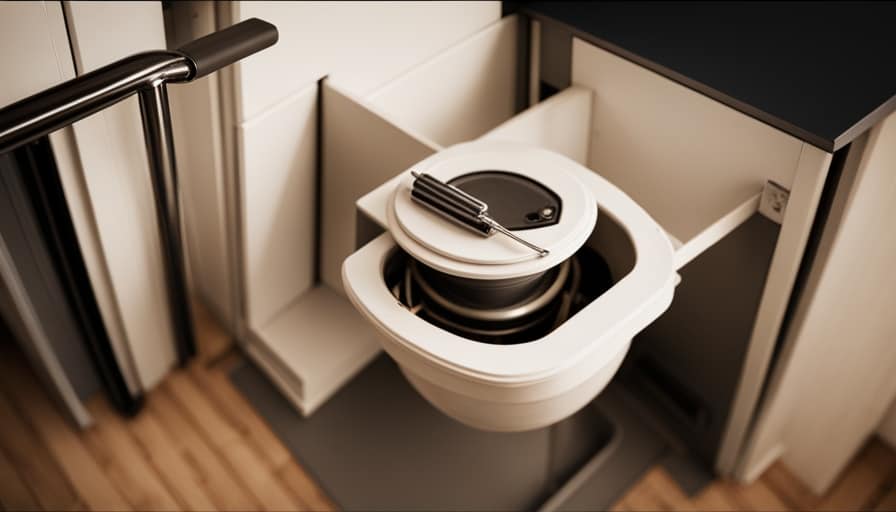
-
Research different lenders and loan options specifically tailored for tiny house purchases.
-
Explore grants and subsidies that may be available for sustainable or low-income housing projects.
-
Consider crowdfunding or personal loans as alternative financing options.
-
Cost-Saving Measures:
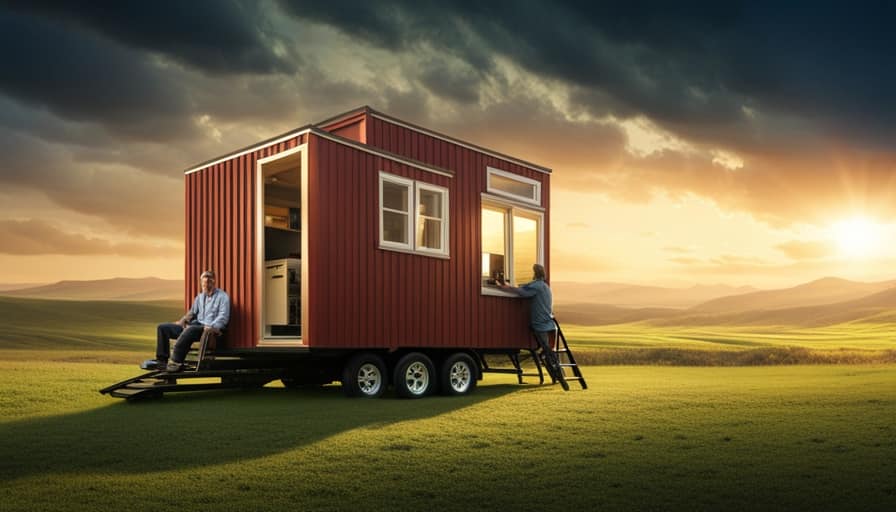
-
Opt for a DIY approach to build your tiny house, if you have the necessary skills and time.
-
Purchase pre-owned or salvaged materials to reduce costs.
-
Utilize energy-efficient appliances and sustainable design practices to save on utility bills in the long run.
Finding a Tiny House Builder or Seller in NY
How can I find a tiny house builder or seller in NY?
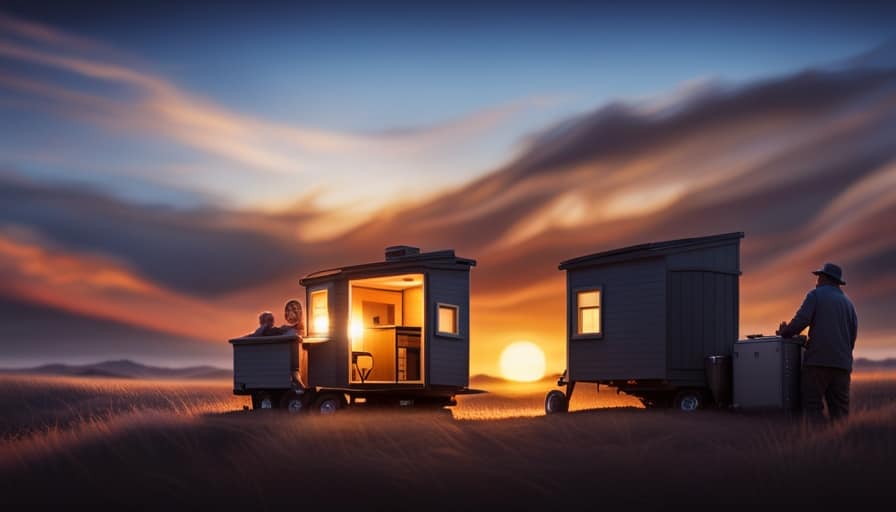
When it comes to finding a tiny house builder or seller in New York, there are a few options you can explore. One way is to search online for local builders or sellers who specialize in tiny houses. You can also attend tiny house events or workshops in the area, where you can meet builders and sellers directly.
Another option is to join online communities or forums dedicated to tiny house enthusiasts, as they often have recommendations and connections for builders and sellers. When looking for a builder or seller, it’s important to consider your specific needs and preferences, such as the style and size of the tiny house.
Additionally, you should weigh the pros and cons of living in a tiny house in NY, taking into account factors like zoning regulations and available amenities. Understanding the legal and zoning requirements for tiny houses in NY is crucial to ensure a smooth and legal purchase.
Transitioning into the next section, let’s explore the legal and zoning requirements for tiny houses in NY.

Understanding the Legal and Zoning Requirements for Tiny Houses in NY
Understanding the legal and zoning requirements for tiny houses in NY is essential before making a purchase. Here are some key points to consider:
-
Understanding the building codes and permits for tiny houses in NY:
-
Familiarize yourself with the New York State Building Code and local building codes.
-
Determine if your tiny house meets the requirements for a recreational vehicle or if it needs to comply with residential building codes.
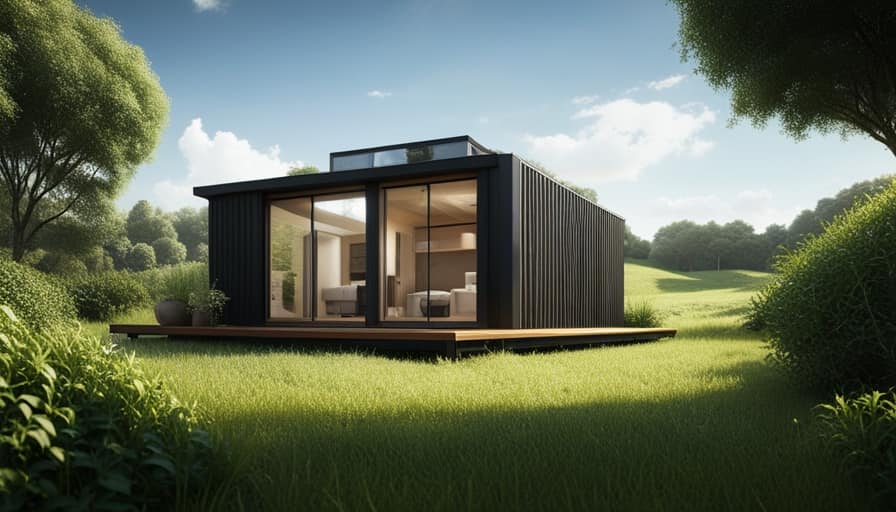
-
Research the necessary permits and inspections required for your tiny house construction.
-
Navigating the challenges of finding suitable land for a tiny house in NY:
-
Research local zoning ordinances and restrictions on tiny houses.
-
Consider purchasing land in an RV park or a tiny house community that allows for tiny house living.

-
Explore the possibility of renting land from a landowner who’s open to hosting a tiny house.
Financing and Insuring Your Tiny House in New York
Finding financing and insuring a tiny house in New York can be a complex process, but it’s crucial for ensuring the protection and affordability of your investment.
When it comes to financing options, there are a few routes you can explore. One option is to obtain a personal loan from a bank or credit union. This can be a good option if you have a good credit score and a stable income.
Another option is to consider taking out a home equity loan if you already own property.

As for insurance coverage, it’s essential to protect your tiny house from potential risks such as fire, theft, or natural disasters. You can typically find insurance providers that offer coverage specifically tailored for tiny houses.
It’s important to compare different insurance policies and choose one that suits your needs and budget.
Frequently Asked Questions
Can I Bring My Own Tiny House From Another State and Live in It in New York?
Yes, you can bring your own tiny house from another state and live in it in New York. However, it is important to research and comply with the zoning regulations for tiny houses in NY.
Are There Any Restrictions on the Size or Height of a Tiny House in New York?
Zoning regulations and building permits in New York may impose restrictions on the size or height of a tiny house. It’s essential to research and consult with local authorities before purchasing to ensure compliance.

Can I Rent Out My Tiny House as a Vacation Rental or on Airbnb?
Yes, you can rent out your tiny house as a vacation rental or on Airbnb, but it is important to familiarize yourself with rental regulations and zoning laws in your area to ensure compliance.
Are There Any Tax Benefits or Incentives for Owning a Tiny House in New York?
Tax benefits and financing options for owning a tiny house in New York can provide significant advantages. These incentives can help reduce expenses and make the purchase more feasible. It’s important to explore these options when considering buying a tiny house in NY.
Can I Build My Own Tiny House in New York Without Hiring a Professional Builder?
Sure, you can definitely build your own tiny house in NY without hiring a pro. Just make sure to familiarize yourself with building regulations and obtain the necessary permits. DIY-ing can be rewarding and cost-effective.
Conclusion
If you’ve been dreaming of owning a tiny house in the vibrant state of New York, your journey begins with thorough research, setting a budget, and finding a reputable builder or seller.

Understanding the legal and zoning requirements specific to New York is crucial, and don’t forget to explore financing and insurance options.
With careful planning and patience, you’ll soon be enjoying the unique and fulfilling lifestyle that a tiny house in the Empire State can offer.
Get ready to embark on an exciting and rewarding adventure!
I’m Theodore, and I love tiny houses. In fact, I’m the author of Tiny House 43, a book about tiny houses that are also tree houses. I think they’re magical places where imaginations can run wild and adventures are just waiting to happen.
While tree houses are often associated with childhood, they can be the perfect adult retreat. They offer a cozy space to relax and unwind, surrounded by nature. And since they’re typically built on stilts or raised platforms, they offer stunning views that traditional homes simply can’t match.
If you’re looking for a unique and romantic getaway, a tree house tiny house might just be the perfect option.
Coolers and Freezers
Are Coolers Airtight?


Dry ice
Utilizing dry ice in coolers is an excellent method for maintaining a cool temperature. Add a layer of dry ice, about a few inches thick, on top of the items in your cooler. This strategy helps in trapping the cold air inside, preventing it from escaping, and ensures that even items at the bottom stay cold. If you’re out of dry ice, consider lining your cooler with newspapers or similar materials as an alternative solution.
Before you put any food in a cooler, make sure you have pre-frozen it. This will prevent the cooler from becoming spoiled by thawing. To prevent perishables from thawing, you can wrap them in newspaper.
Insulation
Insulated coolers are small containers that are lined with insulation to keep cold food cold. There are many different styles and designs available. Some are made of reinforced styrofoam while others use plug in technology to draw electricity from your generator or car. Some coolers will come with ice packs.
Insulated coolers will keep out as much heat possible. Styrofoam is a common type of insulation found in coolers. It is inexpensive and can be cut to exact measurements. They are then covered with plastic molds to protect the insulation from water damage. Some cheaper models are blow molded and use polypropylene and HDPE plastic. These models are BPA-free. The lower-end versions have no insulation and have a space for air. These coolers are less effective at keeping drinks chilled than the more expensive models.
Ice
It is essential that you get an ice-cooler that is airtight if you plan to keep drinks cold. Although most commercial coolers are sealed, this doesn’t mean they can’t be influenced by the outside air. They can actually be cooled more efficiently if the outside air is kept out.
You can get an ice cooler that’s airtight, but you might still want to make sure it’s vented. This is because carbon dioxide can build up in sealed, enclosed spaces and accumulate in lower areas. Most coolers are made to be as leak-proof as possible and have thick insulation to keep the contents cool.
Ventilation
Proper ventilation is critical to the successful operation of a cooler. Lack of ventilation can lead to a variety of problems, including excessive humidity and loading issues. It can also be difficult to justify the cost of ventilation in a cooler. Local authorities may also require that refrigeration systems include ventilation.
There are many ways to ventilate coolers. One way is to measure CO2 levels and modulate the ventilation to keep the level above the ambient concentration. While this approach will not meet the current code requirements, it may be acceptable in many jurisdictions.
Ice pack
A cooler can be equipped with an ice pack to keep food and beverages cold. These packs are usually equipped with a lid to protect from water. A leaky icepack can cause damage to the contents. You can repair a leaky icepack by using a damp cloth to remove any liquid.
Ice packs are available in many different sizes, and they are designed for specific purposes. There are thin ice packs that fit in a lunchbox and ice packs that can freeze quickly and hold their coldness for a long time. Make sure to read the product description carefully to find the right one for your needs. Some products only guarantee a freeze temperature of 4 to 6 hours, while others can keep your items frozen for up 24 hours.
Hi, I’m Emma. I’m the Editor in Chief of Tiny House 43, a blog all about tiny houses. While tree houses are often associated with childhood, they can be the perfect adult retreat. They offer a cozy space to relax and unwind, surrounded by nature. And since they’re typically built on stilts or raised platforms, they offer stunning views that traditional homes simply can’t match. If you’re looking for a unique and romantic getaway, a tree house tiny house might just be the perfect option.
-

 Beginners Guides2 weeks ago
Beginners Guides2 weeks agoHow To Buy A Tesla Tiny House
-

 Energy Efficiency2 months ago
Energy Efficiency2 months agoBest Tiny Homes For Cold Climates
-

 Beginners Guides1 week ago
Beginners Guides1 week agoTiny House Nation Where Are They Now Stephanie
-

 Tiny House Resources (e.g., legalities, cost, insurance, FAQs)2 months ago
Tiny House Resources (e.g., legalities, cost, insurance, FAQs)2 months agoDo Tiny Homes Need Planning Permission?
-

 Beginners Guides3 weeks ago
Beginners Guides3 weeks agoFrom The Show Tiny House Nation How Many Keep Their Tiny House?
-

 Beginners Guides2 months ago
Beginners Guides2 months agoUsing a Climbing Net For Treehouse Construction
-

 Beginners Guides2 months ago
Beginners Guides2 months agoHow to Build a Treehouse Without Drilling Into the Tree
-

 Beginners Guides3 weeks ago
Beginners Guides3 weeks agoTiny House Nation Who Pays For The Houses













